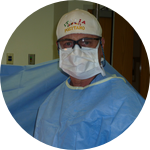About This Project
We hypothesize that female mosquitoes optimize their proboscis strength and flexibility for nectarivory differently than male mosquitoes. To test this, we will use energy dispersive x-ray spectroscopy to determine the elemental composition of the mouthparts in male and female mosquitoes of three different species known to transmit zoonotic diseases. Through elemental analysis, we may better understand how these vectors use their proboscis for efficient penetration.
Ask the Scientists
Join The DiscussionWhat is the context of this research?
Mosquitoes are some of the most harmful disease vectors on the planet, known to transmit viruses, bacteria, protozoans, and animal parasites. Only the female mosquitoes are vampires, taking a blood meal. Male mosquitoes consume only nectar, while females consume nectar before blood meals. We hypothesize that the female proboscis has adapted in a significant way to consume blood. Does the female mosquito reinforce the exoskeleton with metals to enhance penetration? Do different species of mosquito have different elemental signatures?
What is the significance of this project?
Many arthropods such as insects, spiders and scorpions are well known to reinforce their exoskeletons with metals (e.g., zinc, calcium). These metals are proposed to add strength and rigidity to appendages that are used to immobilize and pierce prey, e.g., spiders do this with their fangs! Mosquitoes have a piercing proboscis, but surprisingly, its elemental composition has never been explored. We hypothesize that female mosquitoes balance their need for strength for penetration and flexibility for nectarivory different from male mosquitoes. We chose to analyze 3 disease-transmitting species: Anopheles quadrimaculatus (Malaria), Aedes aegypti (Zika virus), and Culex quinquefasciatus (West Nile virus, lymphatic filariasis).
What are the goals of the project?
We hypothesize that female mosquitoes balance their need for strength for penetration and flexibility for nectarivory different from male mosquitoes. We will test this by using energy dispersive x-ray spectroscopy to characterize the probosicis of male and female mosquitoes of Anopheles quadrimaculatus, Aedes aegypti, and Culex quinquefasciatus. This method allows us to test for elemental composition of mosquito mouthparts. We will compare the results using energy dispersive x-ray spectroscopy between males and female mosquitoes for the three species.
Budget
The budget is focused exclusively on preparation of specimens for electron microscopy (sputter coating) and use of the JEOL scanning electron microscope housed in the Materials Characterization Laboratory at the University of Massachusetts Lowell.
Endorsed by
 Project Timeline
Project Timeline
Dissection and breeding of mosquito samples will take place in Dr. Hochberg’s Lab. Elemental composition analysis via FE-SEM and EDS will take place in the Materials Characterization Laboratory at the University of Massachusetts Lowell. The results will be collated and prepared for publication in The Journal of Parasitology. Lastly, the results will be used to produce a presentation at the American Society of Parasitologists (ASP).
Jun 01, 2019
Begin breeding of three species of mosquito
Jun 17, 2019
Dissection of mosquitoes and preparation for SEM-EDS
Jul 01, 2019
Begin studies on the FE-SEM instrument
Aug 30, 2019
Complete FE-SEM research
Sep 02, 2019
Begin collating data for publication
Meet the Team
Vickram Andrew Manoharan
I am a Biology graduate student at the University of Massachusetts in Lowell. I have been interested in biological sciences since I was gifted a light microscope at a young age. That was the spark which turned into a flame of curiosity over the years, fueling my desire to learn more about all living organisms in the world we live in.
The research I work on with my partner concerns all who are at risk of being bit by a mosquito. Unveiling more about these troublesome ectoparasites could help us better defend ourselves against them.
Michaela Burns
As a biology student and avid animal lover, my main goal is to be the voice of these animals and provide them with the love and care that they deserve.
With a background in parasitology, my goal is to help educate pet owners on the dangers that mosquitos can cause. My partner and I wish to conduct this research in order to better understand these ectoparasities for the sake of its animal and human prey alike.
Lab Notes
Nothing posted yet.
Additional Information
General Work Flow
1. Eggs and larvae of three species of mosquitoes will be obtained from Benzon Research and lab grown to full adults
2. Eggs/larvae will be cultured in mosquito trap containers at 75˚F and fed mosquito larvae powder for 1-3 weeks to reach adulthood
3. Adult mosquitoes will be euthanized in the freezer (-20 C) and separated by sex
4. Mouthparts will be dissected with a dissection microscope
a. Mosquitoes will be briefly submerged in distilled water to soften the cuticle
b. The mosquito head will be detached from the thorax
c. Proboscis will be carefully dissected with 000 insect pins to expose individual mouth appendages
5. Head will be mounted on graphite SEM stubs
6. Stubs will be sputter coated with gold (for imaging)
7. Field Emission Scanning Electron Microscopy (FESEM) will be used to capture images of the mouthparts
8. Electron Dispersive X-ray Spectroscopy will be used to identify the metal elements in the different mouthparts
Project Backers
- 18Backers
- 121%Funded
- $843Total Donations
- $46.83Average Donation





